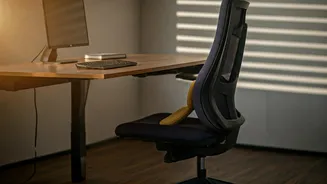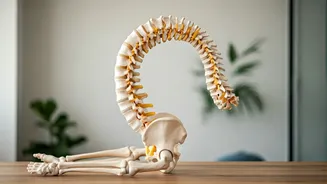Understanding Office Back Pain
Many individuals working in offices experience back pain, often stemming from extended periods of sitting. This sedentary lifestyle can weaken core muscles
and cause spinal misalignment. The lack of movement and poor posture contribute to muscle stiffness and discomfort. Furthermore, the ergonomics of the workplace, like improperly adjusted chairs or desk setups, play a significant role. Over time, these factors can result in chronic back issues. Awareness of these root causes is crucial for proactively managing and preventing back pain.
Posture Perfecting Routine
Maintaining good posture is pivotal in preventing back pain. Start by ensuring your chair provides adequate lumbar support. Sit with your feet flat on the floor or on a footrest, knees aligned with or slightly below your hips. Your monitor should be at eye level to avoid neck strain. Regularly check your posture throughout the day, ensuring your shoulders are relaxed and your back is straight. Simple adjustments like these can significantly reduce strain on your spine. Consider setting reminders to check and correct your posture every 30 minutes to maintain good habits.
Stretches for the Spine
Incorporate simple stretches into your daily routine to relieve back pain and improve flexibility. Start with a seated spinal twist, gently turning your torso to one side while maintaining a straight back. Hold for a few seconds, then repeat on the other side. Next, try a seated cat-cow stretch, alternating between arching your back (cat) and rounding your spine (cow). These movements promote flexibility and ease muscle tension. Additionally, perform a gentle chest stretch by clasping your hands behind your back and pulling your shoulder blades together. Doing these stretches several times a day can offer significant relief.
Micro-breaks and Movement
Regular micro-breaks are essential to counteract the negative effects of prolonged sitting. Set a timer to stand up and move around every 30 minutes. Take short walks, stretch, or do some simple exercises. Even a few minutes of activity can make a significant difference. Consider using a standing desk for part of the day to vary your posture. Incorporate desk exercises like shoulder rolls, neck stretches, and leg extensions during your breaks. These active breaks help improve circulation, reduce muscle stiffness, and refresh your mind, promoting a healthier work experience overall.
Ergonomics and Work Setup
The way your workspace is set up profoundly affects your back health. Ensure your chair is ergonomically designed, providing proper support for your lumbar spine. Adjust your desk height so your elbows are at a 90-degree angle when typing. Place your monitor at an arm's length away and at eye level. Consider using an external keyboard and mouse to prevent strain from using a laptop. Additionally, make sure your workspace is well-lit to reduce eye strain, which can indirectly affect your posture. Regularly assess and adjust your setup to maintain optimal comfort and support.
Mindful Breathing Techniques
Incorporate mindful breathing exercises to alleviate stress and tension, which can exacerbate back pain. Practicing deep, controlled breaths can help relax muscles and reduce discomfort. During your breaks, take a few moments to focus on your breath. Inhale deeply through your nose, allowing your abdomen to expand, and exhale slowly through your mouth. This technique helps calm your nervous system and reduce muscle tension. Experiment with different breathing techniques, such as diaphragmatic breathing, to discover what works best for you. Regular practice can lead to a more relaxed and pain-free experience.











